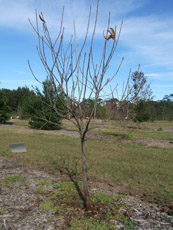Amelanchier arborea (Downy Serviceberry)

*Click on picture for more images of this species.
- USDA Hardiness Zone: 5A - 8B
- Mature Height: 20 to 30 ft
- Mature Spread: 15 to 20 ft
- Growth Rate: Slow
- Availability: Somewhat available in small sizes
- Drought Tolerance: Moderate
- Salt Tolerance: Moderate
- Light Requirements: Full sun to partial sun.
- Native Origin: Native to Florida.
- Soil Drainage: Tolerates well-drained sites to occasionally wet sites.
- Foliage: Deciduous tree with showy fall color.
- Flowers: White, very showy flowers in the spring.
- Pests: The main insect pests are miners, borers, spider mites and aphids. The main diseases are witches broom, powdery mildew, cedar rust, fire and leaf blight.
Description: Downy Serviceberry grows 20 to 30 feet tall and can spread to about 20 feet. This native large shrub or small tree has a moderate growth rate in most soils. Multiple stems are upright and highly branched forming a dense shrub with many small-diameter branches or, if properly pruned, a small tree. Trees can be trained to, and may be offered by some nurseries, with one trunk. The main ornamental features are white flowers followed by purple fruit in late spring or early summer. Fruits are produced before the leaves in spring and are quickly eaten by birds.
Serviceberry puts on a some fall color display in north Florida ranging from yellow and orange to dull red. This tree is suitable for naturalistic plantings and will attract birds. The tree suckers from the base of the trunk, which can be a maintenance problem in urban plantings or in formal landscapes. Although native trees are often found growing along stream banks as an understory tree, they also tolerate somewhat drier soils, and may grow well in urban areas once established. They may lose some leaves in drought to avoid injury in dry weather. They are well-suited for planting in shrub borders and in wet soils. Their small stature and moderately-slow growth rate make it ideally suited for planting beneath power lines, if provided with some irrigation during drought.
Gainesville Observations: Flowers in late February and early March. Tree canopies have not really filled in despite being planted 2 years ago. Growth is very slow and one tree died. No pruning has been done; we are waiting until trees grow more to begin directing growth. Foliage dries some and drop in summer. I suspect the root systems on our trees were poor.

